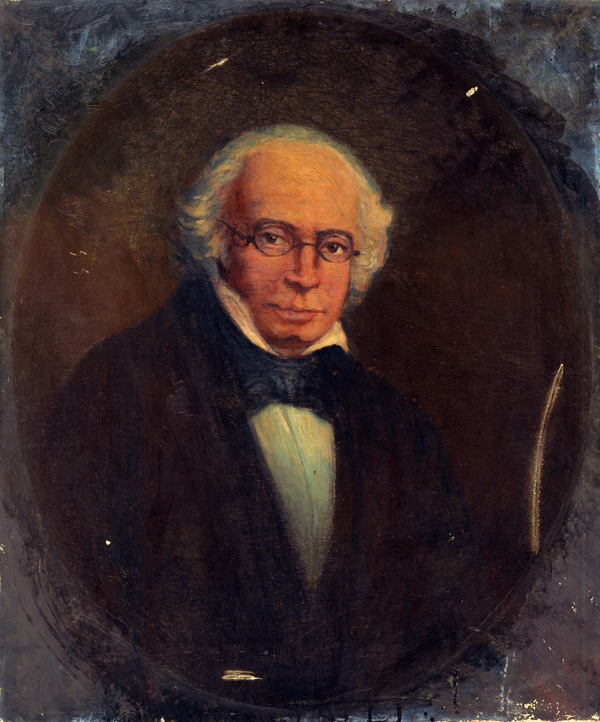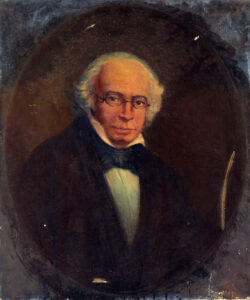West Florida Revolt
The Florida Parishes weren’t included in the Louisiana Purchase but instead were added to Louisiana after an armed revolt against the Spanish colonial government.
This entry is 7th Grade level View Full Entry

Louisiana State Museum
A ca. 1916 portrait of Don Carlos de Hault de Lassus, governor of Spanish West Florida.
Why weren’t the Florida Parishes included in the Louisiana Purchase?
Among the most common misconceptions about Louisiana is the belief that the entire modern state was included in the 1803 Louisiana Purchase. The Florida Parishes weren’t included in the purchase or in the state of Louisiana as originally constituted. Located in the southeastern part of the state, the Florida Parishes include present-day East Baton Rouge, East Feliciana, Livingston, St. Helena, St. Tammany, Tangipahoa, Washington, and West Feliciana Parishes. The geographic boundaries on today’s maps weren’t created until an armed rebellion against the government took place in 1810.
Located north of Lake Pontchartrain in the “toe” of the present-day state, Louisiana’s Florida Parishes were known as West Florida, and were part of Spain’s colonial empire. However, the area was only loosely controlled by Spain and was home to a mishmash of settlers, including British loyalists who avoided persecution by American revolutionaries, army deserters, and desperadoes who flourished in the absence of government control.
In advance of the Louisiana Purchase, President Thomas Jefferson instructed his representatives to secure West Florida to ensure American control of the east bank of the Mississippi River. Although Jefferson’s representatives gained far more territory in the purchase than they could have imagined, West Florida wasn’t included, as it remained under Spanish—not French—authority in 1803. American officials later argued that it was included, and the dispute made the area ripe for rebellion.
What are the major events surrounding the West Florida Revolt?
After the details of the Louisiana Purchase were revealed, the pro-American population in the territory was disappointed that West Florida was excluded. This disappointment was especially evident in the wealthy Feliciana District near the Mississippi Territory border. There were others who remained loyal to Spain, including British loyalists who were hostile to the new American republic, and people who held British and Spanish land grants who feared American control. Spain’s hands-off approach to governance and lack of taxation appealed to others in the area. Therefore, when a group of Mississippi Territory rebels led by Ruben Kemper and his brothers crossed into West Florida in 1804 to attack the Spanish fort at Baton Rouge, many residents rallied to help the Spanish fight off the invasion.
Three distinct groups emerged in the territory after the failed Kemper Rebellion. The pro-American side favored independence from Spain and annexation by the United States. The second, and perhaps largest, group remained loosely loyal to Spain, mostly because of government patronage, fear of prosecution in American courts, or to protect their land. The third group, known as independents, wanted a new republic under their own authority. The writings of the independents suggest that members knew their little republic couldn’t sustain itself for long among greedy world powers, but they were still a powerful voice for the creation of a new republic.
The rebellion was sparked by events in Europe. At almost the same time as French plots compromised Spanish authority in Spain, the popular governor of West Florida, Don Carlos de Grand-Pre, was replaced by the bland and uncertain Carlos de Hault de Lassus. Despite his good intentions, de Lassus was late to the game of high-stakes intrigue. Due to growing French control of the Spanish Crown, de Lassus tried to strike a friendly tone with pro-independence factions in West Florida. On June 23, 1810, a large group of Feliciana residents gathered at Egypt Plantation and called for the establishment of a convention, supposedly to “secure themselves against foreign invasion and domestic disturbance.” Four men were selected as delegates—with authority to solicit representatives from the neighboring districts of Baton Rouge, St. Helena, and Chifoncte—to attend a convention scheduled for July 25, 1810, at St. Johns Plains.
John Rhea of Feliciana was elected chairperson of the convention. To avoid provoking Spain’s wrath, the assembled delegates avoided rebellion and instead drafted a resolution declaring their intention to assist de Lassus in governing the territory, due to his weakened capacity caused by events in Europe. Despite the clear overthrow of authority, de Lassus feigned acceptance probably because he had only twenty-eight troops at his disposal. During the next few weeks, he hosted a series of “peace dinners,” replete with the firing of salutes by the artillery at the fort where he wined and dined the convention delegates. In the fort Spanish officers were outraged by his recklessness. Despite his troops’ frustrations, the governor kept shifting his position.
Other Spanish loyalists were more decisive. William Cooper, the delegate from the Chifoncte district, secretly wrote Spanish Governor Vincente Folch in Pensacola. Cooper explained that the convention was really a front for a rebellion engineered by planters in Feliciana. Cooper urged Folch to lead a force of troops to the district and restore Spanish authority. He further advised that he, along with prominent planter Michael Jones and others, was rallying troops and constructing fortifications to support Folch when he arrived.
De Lassus finally decided to act because he didn’t want to be accused of involvement in a coup. Among his friends was Shepard Brown, presiding official of the St. Helena district, who had earlier promised the governor he could raise five hundred men to help. Isolated and desperate, de Lassus wrote Brown to ask for help. Governor Folch was to get a second message asking him to send troops but a group of men loyal to the convention intercepted de Lassus’s messenger and detained him before delivering his messages to the convention instead of Folch.
Because of the governor’s deception, convention delegates gathered at Troy Plantation near St. Francisville and admitted they were now in danger of being arrested for treason. Deciding to act quickly to try to overthrow Spanish rule, the convention sent Philemon Thomas to lead a force of volunteers to storm Baton Rouge in preparation for a declaration of independence. Thomas dispatched riders to the outlying districts, calling for men to gather on the outskirts of Baton Rouge that night. Armed men from Feliciana, St. Helena, and Springfield approached Baton Rouge.
The Spanish in Baton Rouge were on alert as the rebels gathered just outside the town. De Lassus received at least two warnings that day, one from a Spanish loyalist in St. Francisville saying inhabitants of Bayou Sara were armed and hostile. Although de Lassus doubled the guards at the fort, he didn’t do anything to stop the rebels. Despite the fort’s poor condition, the governor seemed confident the fort’s artillery, which included canons, would hold off the rebels.
Thomas knew that if he tried to attack the fort from the front, his troops would likely be faced with canon fire, especially if he waited until daylight. Thomas ordered some of his men to sneak into the fort. His men gained access under cover of darkness and early morning fog by blending in with dairy cows that entered the fort each morning. After a short firefight, the rebels quickly overpowered the Spanish and raised the convention flag over the fort. In response to Thomas’s advance, the West Florida Convention immediately endorsed the rebels and ordered him to lead a force of 400 men to take over the rest of the region. Shepard Brown and Michael Jones, two loyalists to the Spanish government, submitted to the rebel force and pledged loyalty to the new republic. In Springfield, William Cooper assembled another force to fight the rebels, but when he heard how big the “army” was that was approaching, they dispersed. Cooper was captured and killed by the rebels, provoking deep resentment in the Tchefuncte and Tangipahoa River regions.
After the rebellion President James Madison ordered Louisiana governor William C. C. Claiborne to claim the territory for the United States. Claiborne entered the territory with overwhelming force, arriving with both ground troops and a naval fleet. On December 10, 1810, rebels reluctantly lowered the flag of the Republic of West Florida, bringing an end to the revolt, which had lasted just seventy-four days. Despite some lingering resentment concerning land claims and army deserters, no further popular uprisings took place.
